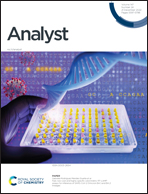Glucose oxidase-encapsulated liposomes for amplified autofluorescence-free immunoassay of a prostate-specific antigen with photoluminescence of CePO4:Tb nanocrystals†
Abstract
Lanthanide-doped inorganic nanocrystals have attracted extensive attention due to their long luminescence lifetime and large Stokes shift. In this work, an immunosensing platform based on CePO4:Tb (CPOT) was successfully constructed, which could avoid the autofluorescence interference of complex biological matrices. Specifically, CPOT was synthesized by a solvothermal method, which exhibited H2O2-responsive luminescence behavior. Taking advantage of this feature, an autofluorescence-free immunosensor with CPOT as the probe and H2O2 as the quencher was developed to detect prostate-specific antigen (PSA). Functionalized liposomes were used to encapsulate glucose oxidase (GOD) and labeled on detection antibodies to improve the sensitivity of the probe. Under the proven optimal experimental conditions, the developed autofluorescence-free immunosensor exhibited a linear luminescence response to the logarithm of PSA concentration (0.005–25 ng mL−1) with a limit of detection (LOD) of 3.25 pg mL−1. The performance shows that the autofluorescence-free immunosensor based on this strategy opens up a new field of vision for clinical PSA detection.

- This article is part of the themed collection: Analyst HOT Articles 2022


 Please wait while we load your content...
Please wait while we load your content...